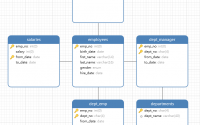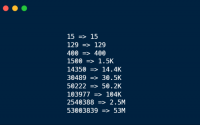让MySQL搜索区分大小写或排序时分大小写方法如下: 1.在SQL中强制 SELECT `field` FROM `table` WHERE BINARY…
Node.js: exports 和 module.exports 的区别
我理解的exports 和 module.exports 的区别,欢迎大家吐槽~
为了更好的理解 exports 和 module.exports 的关系,我们先来补点 js 基础。示例:
app.js
var a = {name: 'nswbmw 1'};
var b = a;
console.log(a);
console.log(b);
b.name = 'nswbmw 2';
console.log(a);
console.log(b);
var b = {name: 'nswbmw 3'};
console.log(a);
console.log(b);
运行 app.js 结果为:
D:\>node app
{ name: 'nswbmw 1' }
{ name: 'nswbmw 1' }
{ name: 'nswbmw 2' }
{ name: 'nswbmw 2' }
{ name: 'nswbmw 2' }
{ name: 'nswbmw 3' }
D:\>
解释一下:a 是一个对象,b 是对 a 的引用,即 a 和 b 指向同一个对象,即 a 和 b 指向同一块内存地址,所以前两个输出一样。当对 b 作修改时,即 a 和 b 指向同一块内存地址的内容发生了改变,所以 a 也会体现出来,所以第三四个输出一样。当对 b 完全覆盖时,b 就指向了一块新的内存地址(并没有对原先的内存块作修改),a 还是指向原来的内存块,即 a 和 b 不再指向同一块内存,也就是说此时 a 和 b 已毫无关系,所以最后两个输出不一样。
明白了上述例子后,我们进入正题。 我们只需知道三点即可知道 exports 和 module.exports 的区别了:
exports是指向的module.exports的引用module.exports初始值为一个空对象{},所以exports初始值也是{}require()返回的是module.exports而不是exports
所以:
我们通过
var name = 'nswbmw';
exports.name = name;
exports.sayName = function() {
console.log(name);
}
给 exports 赋值其实是给 module.exports 这个空对象添加了两个属性而已,上面的代码相当于:
var name = 'nswbmw';
module.exports.name = name;
module.exports.sayName = function() {
console.log(name);
}
我们通常这样使用 exports 和 module.exports
一个简单的例子,计算圆的面积:
使用 exports
app.js
var circle = require('./circle');
console.log(circle.area(4));
circle.js
exports.area = function(r) {
return r * r * Math.PI;
}
使用 module.exports
app.js
var area = require('./area');
console.log(area(4));
area.js
module.exports = function(r) {
return r * r * Math.PI;
}
上面两个例子输出是一样的。你也许会问,为什么不这样写呢?
app.js
var area = require('./area');
console.log(area(4));
area.js
exports = function(r) {
return r * r * Math.PI;
}
运行上面的例子会报错。这是因为,前面的例子中通过给 exports 添加属性,只是对 exports 指向的内存做了修改,而
exports = function(r) {
return r * r * Math.PI;
}
其实是对 exports 进行了覆盖,也就是说 exports 指向了一块新的内存(内容为一个计算圆面积的函数),也就是说 exports 和 module.exports 不再指向同一块内存,也就是说此时 exports 和 module.exports 毫无联系,也就是说 module.exports 指向的那块内存并没有做任何改变,仍然为一个空对象 {} ,也就是说 area.js 导出了一个空对象,所以我们在 app.js 中调用 area(4) 会报 TypeError: object is not a function 的错误。
所以,一句话做个总结:当我们想让模块导出的是一个对象时, exports 和 module.exports 均可使用(但 exports 也不能重新覆盖为一个新的对象),而当我们想导出非对象接口时,就必须也只能覆盖 module.exports 。
我们经常看到这样的用写法:
exports = module.exports = somethings
上面的代码等价于
module.exports = somethings exports = module.exports
原因也很简单, module.exports = somethings 是对 module.exports 进行了覆盖,此时 module.exports 和 exports 的关系断裂,module.exports 指向了新的内存块,而 exports 还是指向原来的内存块,为了让 module.exports 和 exports 还是指向同一块内存或者说指向同一个 “对象”,所以我们就 exports = module.exports 。
原文:https://cnodejs.org/topic/5231a630101e574521e45ef8
实例:
exports
app.js
var iKeepStudying = require('ikeepstudying'); //注意路径
iKeepStudying.echo('this is my testing !');
ikeepstudying.js
exports.echo = function(words){ console.log(words); };
module.exports
app.js
var iKeepStudying = require('ikeepstudying'); //注意路径
iKeepStudying('this is my testing !');
ikeepstudying.js
module.exports = ikeepstudying;
function ikeepstudying(words)
{
console.log(words);
}
另外module.exports还可以到处类:
app.js
var iKS = require('ikeepstudying'); // 注意路径
var gd = new iKS();
gd.echo('this is my testing !');
gd.echo(gd.current_dir_name);
ikeepstudying.js
module.exports = ikeepstudying;
function ikeepstudying()
{
console.log('hello...');
}
ikeepstudying.prototype.echo = function(words){ console.log(words); };
ikeepstudying.prototype.current_dir_name = __dirname;
本文:Node.js: exports 和 module.exports 的区别
![]()


